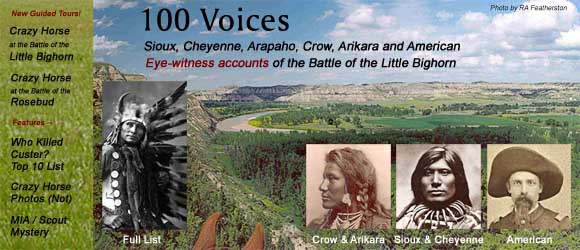|
||||||||||||
Bruce Brown's 100 Voices... George Bird Grinnell's
"FOR MANY years, I [George Grinnell] have been told with much mystery of the stripping of a white man on the Custer field, the man having been dressed in a buckskin coat, high boots, red handkerchief about the neck and tattoo marks on wrist. [Note: here is White Shield's description of this corpse.] This man was probably Tom Custer. I never heard who it was that stripped him, until July 1914, when it came out that it was Little Horse. The party that was stripped was found southwest of where the monument [now] stands at the foot of a little hill. The man seemed to me an officer of the gray horse troops. Some of the Sioux said, "This is the man who brought the soldiers," and then the Sioux women smashed his head with mauls. The man had been scalped"... From the George B. Grinnell Collection, Item 463, Braun Research Library. Cheyenne Memories of the Custer Fight: A Source Book by Richard G. Hardorff, The Arthur Clark Co. Spokane, WA 1995, p 49 - 59
Because the men with the red handkerchief and the tatoo on his wrist was thought by some like White Shield to be Custer, it was also thought by some that Little Horse was Custer's killer. But actually, this man can't be Custer because Custer's corpse was almost unmutilated. If Little Horse killed Tom Custer, then Rain In The Face was telling the truth when he said he didn't do it, despite the Longfellow poem. * * * In his long and distinguished career, George Bird Grinnell was a naturalist with George Custer's 1874 Black Hills expedition, founded of the Audubon Society and was the author of The Fighting Cheyenne. Although not a Cheyenne, or an eye-witness to the battle of the Little Bighorn, George Bird Grinnell shares a crucial quality with the other Sioux, Cheyenne and Crow chroniclers included in 100 Voices. Like Ohiyesa, John Stands In Timber, William Bordeaux, Pretty Shield, Bird Horse and David Humphreys Miller, Grinnell had unique access to important particpants in the Battle of the Little Bighorn. What you see in The Fighting Cheyenne is an intelligent, well-informed and sympathetic telling of the Cheyenne story. Here is Grinnell's chapter on the Battle of the Little Bighorn from The Fighting Cheyenne, and here is his account of Little Horse stripping the corpse of an officer, probably Thomas Custer. -- B.B.
|
||||||||||||




 GEORGE BIRD GRINNELL'S STORY #1
GEORGE BIRD GRINNELL'S STORY #1







